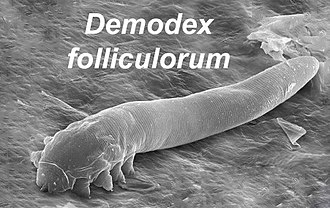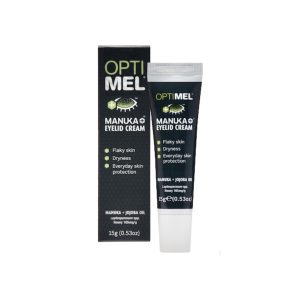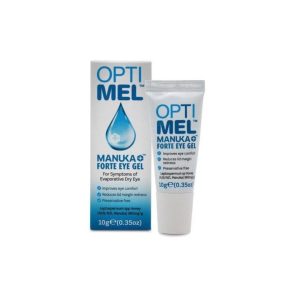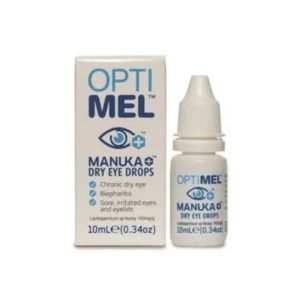Are you experiencing persistent issues such as eye dryness, irritation, or discomfort that refuse to improve?
You may be among the many individuals suffering from a chronic dry eye condition linked to Demodex mites. These tiny, eight-legged organisms naturally inhabit the skin of all humans, particularly around the sensitive areas near the eyes and eyelids. However, when their numbers surge beyond the typical range, it can lead to inflammation that exacerbates dry eye symptoms, severely impacting both your comfort and overall well-being.
If you have been grappling with unexplained dry eye symptoms, it’s essential to evaluate whether Demodex mites might be a key factor contributing to your discomfort.
This detailed guide is designed to assist you in recognizing the signs of a Demodex infestation, understanding how these mites are involved in the development of dry eye disease, and discovering effective treatment options to control their population and alleviate your symptoms.

Recognizing and Understanding the Symptoms of Demodex Blepharitis
Individuals afflicted with Demodex Blepharitis or an excessive presence of these mites around their eyes often encounter a range of distressing symptoms. Common signs include:
- Burning, stinging, or gritty sensations in the eyes, particularly noticeable towards the end of the day.
- Unexplained excessive tearing or watery eyes that are not caused by allergies.
- Red, inflamed eyelids, along with irritation of the skin surrounding the eyes.
- Crusty, dandruff-like buildup along the lashes and lid margins, often manifesting as collarettes.
- Extreme sensitivity to light, making it feel as if your eyes are constantly squinting.
- Episodes of blurred vision that fluctuate throughout the day.
Many individuals endure these dry eye symptoms for years without realizing that an infestation of Demodex mites could be a significant underlying cause of their discomfort and irritation. Understanding these symptoms is crucial in seeking appropriate treatment and restoring comfort to your eyes.

Exploring the Connection Between Demodex Mites and Dry Eye Symptoms
Are you wondering how these microscopic organisms can lead to such troublesome dry eye symptoms? Demodex mites thrive on the natural oils and cells of human skin, establishing their homes within the hair follicles of your eyelashes. As they feast on these natural resources, their waste products, eggs, and dead mites accumulate along the lid margins, creating a thick layer of debris and bacterial biofilm that clogs the delicate oil glands essential for optimal eye health.
When these oil glands are unable to release sufficient oils to maintain the eye’s tear film, dry patches can develop rapidly. This oily tear film is vital for preventing the swift evaporation of the watery tears that keep our eyes moist and comfortable.
Consequently, the inflammation from this blockage can further aggravate eye irritation, redness, and that persistent gritty sensation that many people experience with dry eye. Understanding this connection is critical for effective management and treatment.
Gaining Insight into the Life Cycle of Demodex Mites for Effective Treatment
Comprehending the life cycle of Demodex mites is essential for formulating effective treatment strategies. These mites progress through distinct stages: egg, larva, nymph, and adult, during a life cycle that typically spans between 14 and 21 days. They are most active at night, leaving their hair follicles to mate and deposit new eggs on the skin’s surface.
This nocturnal behavior suggests that the optimal time to apply Demodex treatments is in the evening, just before bedtime. By targeting the mites during their most active hours, you can significantly enhance your chances of eliminating them. However, due to their rapid reproductive capabilities, any surviving mites can quickly repopulate, making it crucial to maintain treatment over several weeks or even months for effective control.
Adopting Proven Treatment Approaches for Demodex-Related Dry Eye
If your optometrist identifies a high population of Demodex mites through eyelash sampling or microscopic examination, they may suggest several treatment methods to effectively manage the infestation:
1. Utilizing Tea Tree Oil Eyelid Wipes and Scrubs for Effective Relief
Products containing tea tree oil are known for their powerful antimicrobial and antiparasitic properties, making them effective in eradicating mites. These solutions can eliminate surface mites, break down collarettes produced by these pests, and draw out hidden mites, rendering them more vulnerable to treatment.
While tea tree oil is remarkably effective against mites, it can cause stinging upon application and may be cytotoxic to healthy cells, potentially aggravating symptoms for certain individuals.
Consistent use of tea tree oil eyelid wipes or scrubs before bedtime can gradually reduce the mite population over time. One highly effective tea tree oil treatment example is OcuSoft Oust Foam, which is particularly beneficial for managing blepharitis primarily caused by Demodex mites.
2. Employing Gentle Hypochlorous Acid Lid Hygiene Sprays for Eye Comfort
Hypochlorous acid is a natural agent produced by our immune system and acts as an effective antimicrobial solution. It is gentle on the eyes, does not induce stinging, and is safe for our cells.
Disinfecting lid sprays and cleansing foams containing hypochlorous acid not only eliminate mites but also reduce inflammation, providing relief from uncomfortable symptoms.
Applying these solutions to the lash lines before bed can effectively kill mites and their debris. These products often have a distinctive odor reminiscent of chlorinated pool water. Examples of hypochlorous acid-based solutions include Ocusoft Hypochlor Spray and Avenova.
We often recommend Ocusoft Hypochlor Foam due to its superior value, featuring an extended shelf life after opening, making it a practical choice for ongoing management.
3. Harnessing the Therapeutic Properties of Manuka Honey for Eye Health
Research suggests that Manuka Honey solutions can be as effective as 50% tea tree oil against Demodex, although further studies are warranted in this area. While it may cause a slight sting upon application, Manuka Honey tends to be less potent than tea tree oil specifically against Demodex, yet it has shown excellent efficacy against other types of blepharitis. It is non-cytotoxic and is less likely to trigger inflammation in the eyelids.
Many patients report that the initial sting is worth it due to the significant relief they experience afterward. Manuka Honey solutions are available in gel form (like Optimel Forte, which is more effective but may sting more) and as drops (like Optimel Drops, which tend to be easier to apply and sting less).
4. Addressing Severe Demodex Infestations with Oral Anti-Parasitics
In cases where Demodex overpopulation is severe and persistent, healthcare professionals may prescribe oral antiparasitic medications. Medications such as Ivermectin in pill form have demonstrated effectiveness in controlling these infestations, as have weekly doses of oral tea tree oil supplements taken over several months to help manage mite levels effectively.
5. Discovering Professional Treatments for Comprehensive Demodex Management
Some specialized eye clinics offer intensive in-office treatments specifically designed for Demodex management. These treatments utilize products such as Oust Demodex Cleanser Swabstix or a specialized hand-held electric brush known as BlephEx.
The Oust Demodex Cleanser Swabst is particularly effective in targeting and eliminating Demodex mites from the eyelid and lash areas, ensuring that your eyes feel refreshed and free from irritation.
The Article: Demodex Mites Linked to Chronic Dry Eye Issues first appeared on https://writebuff.com.







I found this topic particularly intriguing, as I’ve dealt with dry eyes for quite some time and never considered Demodex mites as a potential culprit. It’s fascinating how these tiny organisms can have such a significant impact on our well-being. I’ve recently started incorporating more natural methods into my skincare routine, including regular cleansing around the eye area, and I wonder if that could help manage these mites.
It’s great to hear from someone who’s personally experiencing these issues. Dry eyes can be quite uncomfortable, and it’s interesting how often we overlook the role of tiny creatures like Demodex mites. They really are a part of the bigger picture when it comes to eye health.
It’s great to hear your perspective on this topic. Demodex mites can be surprising culprits in eye issues, and many are unaware of their presence. It’s smart that you’ve started cleansing around your eye area; keeping the skin clean can definitely help manage these tiny organisms. Adding a gentle, natural cleanser could be a good step, just be mindful to avoid anything too harsh that might irritate your skin.
It’s interesting how little we often think about something as small as Demodex mites, right? They really can be sneaky culprits behind all sorts of eye issues. I had a similar experience where I discovered they were causing some irritation for me as well, and it prompted a whole shift in my approach to skincare around my eyes.
It’s interesting to think about how often we overlook the role of such microscopic organisms in our everyday health issues. I’ve been dealing with chronic dry eye symptoms for a while, and it never occurred to me that Demodex mites could be a contributing factor.
It’s fascinating how much goes on at a microscopic level that we’re completely unaware of. Demodex mites are often overlooked, but they can play a significant role in skin and eye conditions. Chronic dry eye symptoms can stem from various factors, and it makes sense to consider these little critters, especially since they can cause inflammation or contribute to other issues. Have you had a chance to talk to a specialist about it? It might be worth exploring treatments that target these mites, like specific eyelid hygiene routines or topical medications. It’s amazing what a different approach can do for overall comfort. Always curious to hear what others discover in their own journeys with such puzzling health challenges.
It’s true—microscopic organisms like Demodex mites often fly under the radar when we think about our health. Chronic dry eye can be so frustrating, and many people don’t realize that these tiny mites might be involved. They thrive in the oil glands around our eyes and can lead to inflammation, which contributes to dryness and discomfort.
It’s fascinating to think about how these tiny creatures can play such a significant role in our health without us even realizing it. Many people are surprised to learn about the potential impact of Demodex mites on conditions like dry eye. These little mites are part of our natural skin flora, but when their population gets out of balance, they can cause irritation and inflammation, particularly around the eyes.
It’s certainly a wild thought, right? Here we are, going about our lives, and the tiniest critters might be throwing a wrench in our eye comfort. Demodex mites aren’t exactly the first thing that pops into our heads when we think of dry eyes. It’s like finding out your favorite sweater has been under the influence of a tiny fashion critic from another dimension!
It’s fascinating how often we overlook the little things that impact our lives, right? Our bodies are like complex ecosystems, and these tiny critters, like the Demodex mites, are just part of a much larger picture. They might not be the first thing we think of when it comes to eye comfort, but their presence can definitely influence our daily experience, especially when it comes to conditions like dry eyes.